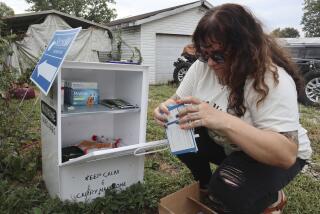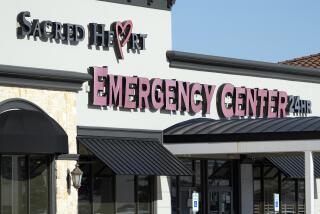The ‘Morning After’ Pill Works Fine If You Can Get It
Complaining that emergency contraceptives are still not within easy reach of many women, health activists are trying to improve access to medication that they say could reduce the nation’s high rate of unplanned pregnancies.
In Los Angeles, Planned Parenthood’s 11 clinics have begun offering most patients a dose of the so-called morning-after pills to take home with them--for a fee of $5--just in case.
And the Los Angeles-based Pacific Institute for Women’s Health recently published two guides--one for consumers and one for health practitioners--to promote awareness of the pills.
“We need to very much keep the pressure on and try to [make] this accessible to the man and woman on the street,” says Francine Coeytaux, an associate of the nonprofit institute. “We do have a lot of barriers still.”
Doctors had long known that certain combinations of ordinary birth control pills can be safely taken within a few days after unprotected intercourse to help prevent pregnancy. But the first dedicated emergency contraceptive, called Preven, became available in late 1998. A second product, called Plan B, arrived in 1999. (They are not the same as the so-called abortion pill, which induces abortion once a pregnancy is established and confirmed.)
The emergency contraceptives, which cause nausea in some women, must be taken within 72 hours after unprotected intercourse. Both are highly effective, giving rise to expectations that the products could make a dent in the estimated 3 million unintended pregnancies and 800,000 abortions that occur each year in the United States.
While surveys show that awareness of emergency contraceptive pills is rising, Coeytaux says: “I think that those who thought this would be the be-all and end-all and would help us reduce abortions are probably realizing now that that’s not true.”
It’s no mystery why emergency contraceptive pills remain more promising than practical.
The problem is time.
“Unlike other [contraceptive] methods, this one has a window of time in which it has to happen, or it’s not effective,” Coeytaux says.
*
Women typically are not offered the pills to have handy for future use and then do not have enough time to obtain them in an emergency, say family planning experts.
Even individuals who call a national hotline listing emergency contraceptive health practitioners often have difficulty getting the pills. A survey of the hotline ([888] NOT-2-LATE) found that 14% of the calls resulted in failure to obtain an appointment or prescription within 72 hours of calling. The study was published in the February issue of the journal Obstetrics & Gynecology.
“The vast majority of providers do a good job. But we were certainly discouraged that people who self-selected to provide emergency contraceptives didn’t do a better job,” says James Trussell, an author of the study and professor of economics and public affairs at Princeton University and a leading advocate of the method. “The bottleneck [in the access process] is that physicians don’t routinely counsel women or prescribe it in advance.”
The study found that some callers failed to even make telephone contact with the provider, that doctors refused to see women who were not established patients, or that appointments were unavailable.
The survey was taken on weekdays, Trussell notes, suggesting that women who try to call for emergency contraceptives on a Saturday morning, when doctors’ offices are usually closed, will encounter even greater obstacles.
And there have been other snags in bringing emergency contraceptives to the marketplace. Under some state laws, pharmacists can refuse to dispense emergency contraceptives if doing so would conflict with their moral or religious beliefs.
But even the majority of pharmacists who are willing to fill prescriptions for Preven or Plan B sometimes don’t have the medication in stock, Coeytaux says. The sooner the medication is taken, the more effective it is.
“The pharmacists haven’t ordered lots of them to have in stock,” she says. “That’s a huge problem. Pharmacists are business people. They only stock a product once they recognize there is a demand. It will take a while for them to realize that people want this.”
Another barrier is cost and insurance coverage. Emergency contraceptives usually cost $20 to $25 (or less in family planning clinics) plus the doctor’s office fee.
Under California law, all contraceptives must be covered by insurance. But emergency contraceptives require special billing procedures in order for providers to be reimbursed--a problem that has caused many rejected claims in California because of doctors’ unfamiliarity with the process, Coeytaux says.
Despite the growing pains, family planning advocates say there are solutions to nearly all of the problems thwarting access to emergency contraceptive pills.
For example, Planned Parenthood is leading the charge to encourage all women of childbearing age to have a dose on hand or to obtain a prescription to fill in an emergency.
The Los Angeles chapter’s distribution of the pills doubled from February to March (from 428 to 976), when the campaign was launched.
“Studies have shown that women are much more likely to use emergency contraception when they need it if they already have it at home,” says Nancy L. Sasaki, president and chief executive of Planned Parenthood Los Angeles.
*
The Pacific Institute for Women’s Health will distribute its physician’s guide to all state-funded family planning providers and 25,000 doctors nationwide to encourage providers to “reduce the steps” that women must go through to obtain the pills.
For example, some doctors still require a woman to have a pelvic exam and pregnancy test before writing a prescription for the pills, although no major medical group mandates this.
Doctors are also urged to issue the pills by telephone, without requiring an appointment, Coeytaux says. The institute’s guide describes how a doctor can conduct safe, careful telephone screening and prescribing of emergency contraceptives.
Doctors need to establish a plan on how to provide fast service to patients at all times of the day and week, Trussell says.
“Physicians haven’t grappled with how to change their practices to deal with this,” he says. “They need to decide how women will get it. Will they prescribe over the phone? Who do they refer a woman to after hours? Providers need to figure out the logistics.”
*
There is also a growing movement to convince state legislators to allow pharmacists to dispense emergency contraceptives. Washington state has such a law. And, in California, a law went into effect in January that allows pharmacists to initiate and monitor drug therapy for individual patients in collaboration with a doctor.
What this means is that a doctor and pharmacist can agree in advance that the pharmacist may treat a particular patient for a given condition, whether it is diabetes or asthma or emergency contraceptive use.
“One of the most valuable aspects of pharmacies is their long hours, weekend hours and the fact that no appointment is necessary,” says Elizabeth Johnson, senior vice president of the California Pharmacists’ Assn. In February, the CPA passed a resolution urging voluntary participation in programs to expand the use of emergency contraceptives, Johnson says.
Finally, Coeytaux says, there is hope that emergency contraceptive pills, because of their safety, will someday be sold over the counter.
That is not expected to happen any time soon. But progress can be made to bring down other barriers, Coeytaux says, “as long as we aim for a rapid response to access.”
(BEGIN TEXT OF INFOBOX / INFOGRAPHIC)
Preven and Plan B
Two emergency contraceptive products are on the market. Preven contains the same hormones found in birth control pills, estrogen and progestin. The pills cause nausea in about half of women. Preven reduces the risk of pregnancy by 75%. Generally, if 100 women have unprotected intercourse in the second or third week of the menstrual cycle, about eight become pregnant. Preven cuts that rate to about two, a 75% reduction.
Plan B contains the hormone levonorgestrel and carries less risk of nausea and vomiting. If the same 100 women used Plan B, only 1 would become pregnant, an 89% reduction over normal risk.
Another levonorgestrel product is expected to come on the market later this year.
*
The Pacific Institute for Women’s Health has two publications on emergency contraception: one for health care providers called “A Clinician’s Guide to Providing Emergency Contraceptive Pills” and one for the general public called “From Secret to Shelf: How Collaboration Is Bringing Emergency Contraception to Women.”
The publications are available from the institute ($6 for “Clinicians Guide” and $10 for “Secret to Shelf”) or by calling (310) 842-6828. They are free on the Web at https://www.piwh.org.
*






